Some people exist as unsung pillars of the underground, and Ray Miller of death metal band Adversary is one of them. First, he started up a zine called Metal Curse that is widely regarded as one of the few quality death metal magazines extant today; next, he began selling death and black metal through his label Cursed Productions, which has also released quality demo compilations from bands such as Varathron and Deceased. Finally, he’s in a death metal band called Adversary which could be described as a more late-night-radio American version of Asphyx. We caught up with him at his country villa in Chingadosmujeres, Mexico, as the first shots of a revolution rang out in the street.
When did ADVERSARY begin?
Just a little over five years ago, in May of 1994. Jack Botos (guitar) and I are two of the original founding members. Our drummer, Bob Burns, is fairly new – he’s been damned with us for about a year-and-a-half.
What’s the distribution of the creative work in songwriting, lyrics, artwork, and concept/pot smoking?
Anyway, in the beginning we had another guitarist, Thom Benford, and he wrote a couple riffs back then. But since he quit (before our first demo was released), Jack and I have written all the music and lyrics. However, when Ed was still in the band (on keyboards and drum programming – before we had a human drummer, of course), he created all the drum and keyboard arrangements. How that would work is that Jack or I would present some riffs, or sometimes a “complete” song (the riffs in the “right” order – we sort of tweaked stuff a lot as we worked on it, so a “finished” song would probably still mutate somewhat), and Ed would listen to us play it a few times and get some ideas.
Then we’d record the riffs on my 4-track, and Ed would work out the programming at home, and at the next practice maybe have something we could play along with. Now that Bob is in the band, we just show him a riff, and he starts playing behind it. Right before Ed quit (he got married…), he had written a few really great riffs for a new song, but we decided to not use them after he left. Not that we parted on bad terms, or anything of the sort.
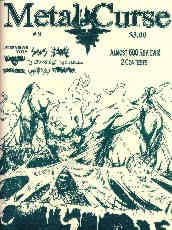 As far as the artwork goes for the band, it’s been different on every release. On our new demo-CD, We Must Be In Hell, Bob brought over few books of photos and paintings, and we basically swiped one. I altered the colors and so on, and did the actual layout myself. I’ve done CD packaging designs for a few underground labels, in addition to my own releases on Cursed Productions.
As far as the artwork goes for the band, it’s been different on every release. On our new demo-CD, We Must Be In Hell, Bob brought over few books of photos and paintings, and we basically swiped one. I altered the colors and so on, and did the actual layout myself. I’ve done CD packaging designs for a few underground labels, in addition to my own releases on Cursed Productions.
I also publish a zine called Metal Curse, and Bob has done 99% of the art for that for the last several issues.
Concept… Well, I suppose our general sound was more or less my idea, being inspired by “simple” Death Metal such as MASSACRE, ASPHYX, (early) GRAVE, UNLEASHED, IMPETIGO, (early) DEATH, AUTOPSY, and onward into countless others. Of course Jack has done his fair share (or more) to shape our sound since. And now, with Bob, we have the added power of human drumming, but we have also lost our keyboards.
So, I suppose our sound is almost constantly evolving, but still hopefully memorable Death Metal. If that’s what you mean by “concept” at all…
As for pot smoking, I leave that to Jack. I don’t smoke, or even drink unless it’s a “special occasion.” So, Jack gets my share. Bob has been known to partake every now and then, too.
The surest way to corrupt a youth is to teach him to hold in higher regard those who think alike than those who think differently.
– F.W. Nietzsche
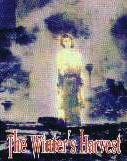 Are you guys touring?
Are you guys touring?
I wish! That’s exactly what we would love to do, but Cursed Productions is too small to support it. That’s one of the reasons we would like to get signed to a larger label: So we can go out and see the world. And the sluts, of course. We do have some shows lined up during the summer, and there is a really slim possibility of us going to Brazil to play some shows with some bands (NERVOCHAOS and INSANITY) on Muvuca Records.
What kind of instruments do you play, and why?
I have a Washburn bass, and a Fender Bassman amp. I like my Washburn because it does not have all that “active electronics” bullshit. It’s old, but I’m attached to it. And speaking of old, my Bassman is nice and fuzzy, and I really like that sound. I think it adds a lot more depth to our live sound than a clean bass tone would. However, when we recorded our debut album, _The Winter’s Harvest_, I was talked into plugging directly into the board, and got a really clear “Steve Harris” kind of sound. That works pretty well for IRON MAIDEN, but I think it made the album sound more “clean” than it should have. Well, and the keyboards and drum machine also added to the “clean” sound… Believe me, I learned my lesson about that, and will stick with my “warm” Bassman sound form now on.
Jack has had a couple different guitars over the years, and he just got a new one. I think he may finally be satisfied with the guitar, but now he’s looking for a bigger, meaner amp.
And my drum knowledge is pathetic, so all I know about Bob’s kit, is that it’s like nuclear explosions going off whenever he hits the snare.
Do you feel it matters, or matters only for aesthetic (“sound” quality, texture, timbre, “feel”) qualities?
What else would it matter? Just to be like B.B. King and his beloved guitar? No, I’m not that attached to any equipment I own, so if I could afford to get a bass and amp that I thought sounded better, I would. But “sounding better” is obviously extremely subjective, and after many years of using this same gear (I’ve had it and been in bands for a lot longer than ADVERSARY has been around), I guess I’m so used to it, that I’m not sure what would sound better. So, maybe I *am* a little like B.B. after all.
The Christian resolution to make the world ugly and bad has made the world ugly and bad.
– F.W. Nietzsche
What are you guys like outside of the band? Do you suffer under the Judeo-Christian pestilence known as “day jobs”? Tattoos? Historical heroes?
Bob and Jack do have “day jobs,” but my full time job is running my label, Cursed Productions. It may seem odd, but none of us have any tattoos. I think we may be the only ink-free Death Metal band in the world! I’m not sure I really have any heroes other than the guys in MOTORHEAD. And, as my pal Psycho would say, “the guy who invented lesbian pornography.”
 Is the ADVERSARY eponym an identification with Satan, the “adversary” of ancient Hebrew religion?
Is the ADVERSARY eponym an identification with Satan, the “adversary” of ancient Hebrew religion?
YES! Thank you. You are exactly the second person to ever ask me that. I had thought it was odd that no one had snatched up the name before us, but I guess not many people understand what it means.
What do you see as the difference between Jewish, Christian, Islamic and Buddhist views of “evil”/”suffering”?
I’m not really well enough versed in Islam and Buddhism to answer that. So, what I’ll do instead is say that mainstream (x-tian at least) religions seem to think that a lot of natural behavior should be considered “evil,” and that seems crazy to me. Fucking, well that’s evil. Killing, no matter what the situation, that’s evil too.
What forms of art, ideas, or actions inspired the inception of your artwork?
Early Death Metal, of course. But also other music, such as MOTORHEAD, VENOM, SLAYER (I believe that you consider them to be a Death Metal band, but that’s open to debate, if you ask me), ACCEPT, DEAD KENNEDYS… Non mainstream music in general. And I suppose that honestly, everything I’ve ever heard has inspired me in some way. Maybe not always in a positive way, though. I also read whenever I can, and have certainly been inspired by the authors I like, such as Charles Bukowski, Henry Miller, Vladimir Nabokov, Italo Calvino, Jorge Luis Borges, William S. Burroughs, Douglas Adams, to name just a very, very few. Plus, as geeky as it might sound, Godzilla movies. I’ve always been a huge fan (excepting the dismal TriStar attempt of last summer) of Godzilla and his monstrous pals. And, horror movies. Zombies, especially, seem to grab my interest. I appreciate the special effects, and I suppose like the thrill.
Do you consider your music a form of “art” (the academic definition, not the trendy one)?
Certainly.
What motive inspires your art?
To create something that will outlast us.To, in sort of a Shakespearean sense, live forever. The hope that someday we might be a source of inspiration for others to creatively express what they feel.And to one day take over for MOTORHEAD as the best, most respected, band in the world.
Or maybe just to meet chicks and take over the world.
 Do you think drugs help/hinder art?
Do you think drugs help/hinder art?
I can’t really answer that, since I don’t use any drugs. But I do think that drugs can be used as a tool to possibly help with creativity. However, they can also be detrimental. As I said, I think they’re a tool, and should be used as such, if at all.
Does religion help/etc?
Well, it sure seems like a lot of Extreme Metal bands these days rely on religious (or more accurately, anti-religious) themes in their lyrics, so I guess it helps them in that way. I think that organized religion is a great way to oppress and control the masses, so it “helps” us by giving us a focus on one of society’s problems: it’s easier to be a sheep than to accept responsibility for your own actions, think for yourself, and be your own person.
Of course, x-tian religions love to censor everything they can, from books to thoughts, so in that way, that kind of religion clearly hinders the creative process.
“They train them to drop fire on men… But they won’t let them write the word FUCK on their aeroplanes… Becuase it’s obscene!”
-Colonel Kurtz, Apocalypse Now!
Violence?
I don’t know if violence has any affect on art, but I suppose that as a society becomes more and more violent, the art it as a whole produces will reflect that.
Television?
Most of what’s on broadcast television is extremely dumbed down, so that even the most idiotic Joe Sixpack will understand it, so generally I see TV as sort of a filter that removes most of what is interesting about life. Even worse when a movie is butchered so that it can be “safely” shown without “offending” anyone.
In your personal lives, how do you understand and respond to the presence of corporate control and material need?
Of course you do need to pay the bills, and obviously I like music and books, so I do my best to bring in cash, and spend it just as well. It would be nice to not have to worry about huge companies like Blockbuster having more than a little control in determining the content of the movies they carry, or Meijer driving all the mom and pop grocery stores out of business, but when faced with the decision of having enough to eat if I get the shit at Meijer, or going hungry from trying to support a local store, I must choose to eat.
What do you think of “jobs”?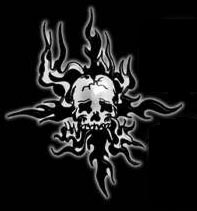
I don’t like them. I am lucky enough to be able to make a very modest living at doing something that I enjoy (Cursed Productions, Metal Curse, and ADVERSARY), but I do put in a lot more time at this than Jack and Bob do combined at their jobs. Sometimes, just for a second, I wonder if it wouldn’t be easier to go work for someone else. Certainly it would be easier, and considerably less work. I could have more “free time” to read and relax. But at what cost? So I could go be a nameless cog in some huge machine that cares not at all about me, as I am utterly replacable? So I could “finally grow up and get a real job”? I don’t think so. To quote Jello Biafra, “I’d rather stay a child and keep my self respect, if being an adult means being like you.” But, then again, if one day Cursed Productions fails to provide me with enough to get by, I will be forced to take other actions. That’s not part of the Global Domination plan, though.
Do you blaspheme on a regular basis for dentological, aka done for the intensity of the action itself, reasons?
Maybe. It seems more appropriate to blaspheme for the reaction it generates in others, whether positive or negative, as both responces are extremely important at various times and in various situations. But just screaming “Fuck god!” in an empty room doens’t do much for me.
Are you moral? Do you believe in morality?
I suppose so, but I certainly have my own morality. What I think is “right and wrong” might not match up with what some people think. I’m fairly close to what LaVey says in the _Satanic Bible_ as far as morality is concerned.
Do you think ethics are separate from morals?
I hadn’t considered it before. Perhaps morals could be seen as a personal code of conduct, while ethics might be viewed as more of a code of conduct for groups or whole societies. Perhaps to remain with the given society, one would have to conform to the ethical “guidelines,” while still retaining his own personal morality that might only come into play in other societies or groups.
What is the most important factor for you in creating music that satisfies you at the deepest level?
Knowing that what we have created is honest and true to us.
If you met Jesus, what would you say?
“Until I see you turn this water into wine, you’re just a punk in sandals.”
Or, maybe upon seeing a “miracle” I couldn’t debunk, “Oh shit!”
Hitler?
If I were back in time, I might say, “Stay out of Russia.” But no matter when I saw him, I’d want to talk about eugenics. What else could you talk to Hitler about?
“God”?
Now that depends on what you mean by “God.” But, playing along for a moment, I’d ask why we exist, and what the purpose of the universe is.
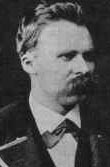 Nietzsche?
Nietzsche?
Maybe I could get him and Hitler together, as the conversations would be pretty related.
Gandhi?
I’d tell him that passive resistance cannot always work.
Without music life would be a mistake.
-F.W. Nietzsche
How would you react if your daughter got breast implants?
Interesting. I’ll try to take this one seriously. From the perspective of a father, I don’t think I’d like it, but I would certainly have to have more information as to why she was doing it. Is it just the fact that she’s small chested and wants to fuck the football team, who will only fuck the big boobed cheerleaders, or does she think that she’ll be better able to control the weak sheep-wills of men and have legions to do her bidding? If she wants to get a boob job so that she can dominate the universe, then okay.
Do you feel society is evolved from the hominid state, aka “ape” social existence with inherent power games?
Evidently not. As George Carlin would say, “It’s the bigger dick policy at work. If they have bigger dicks, bomb them.”
Why do you feel that many experience a dark sense of foreboding regarding the millenium and significant times afterward, such as 2012?
Fear of the unknown, for one thing. And I don’t have to mention that most people are sheep, and that the media has been forcing “millennium fear” on everyone, so it’s only natural that the herd is worried about it. What’s significant about 2012?
2012 is the date the Mayan calendar “ends” an era, with the implication that what comes will be either total destruction or a new frontier. I however think it is the date when the genome of marijuana truly matures, and thus all earth will be unified in clouds of sweet smoke.
More like the number of bong hits you’ve taken during this interview!
Is ADVERSARY is exploring a new type of metal, and an old type of metal, like any other group of self-respecting artists in this age?
Yeah, it’s sort of like my taste in literature: mythological and postmodern.
A giant HAILS and BLACK VOMIT OF ETERNITY to the mighty ADVERSARY for this lengthy interview.Thank you for your time.
You’re welcome of course. I should really thank you for the interest in ADVERSARY.
…The one-eyed man will have one eye the stronger; the blind man will see deeper inwardly, and certainly hear better. To this extent, the famous theory of the survival of the fittest does not seem to me to be the only viewpoint from which to explain the progress of strengthening of a man or of a race.
– F.W. Nietzsche
No Comments
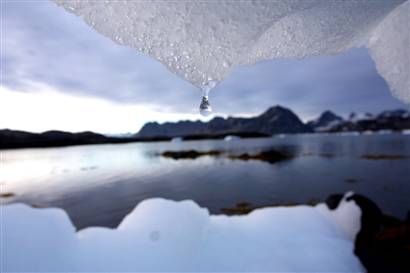
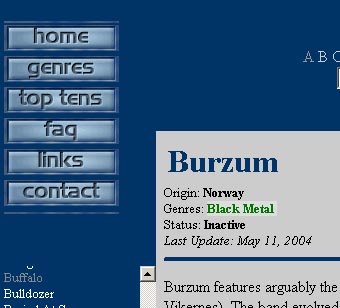
 While Botswana is perhaps best known for its wildlife reserves, a burgeoning counter-culture is painting a very different image of the small south African country.
While Botswana is perhaps best known for its wildlife reserves, a burgeoning counter-culture is painting a very different image of the small south African country. After a new genre establishes itself, bands try to stand out by either mixing other genres into their music or to expand upon the original idea, increasing its complexity and depth.
After a new genre establishes itself, bands try to stand out by either mixing other genres into their music or to expand upon the original idea, increasing its complexity and depth.








